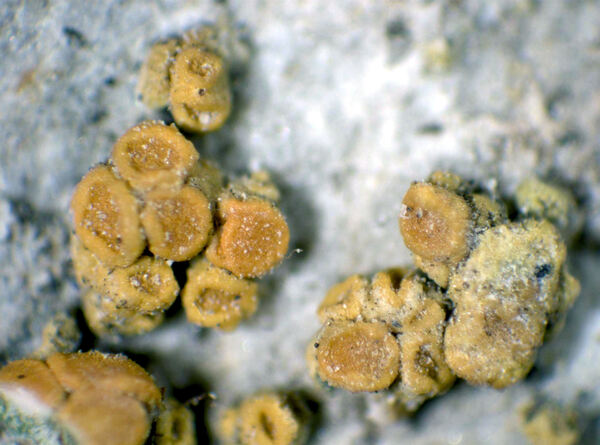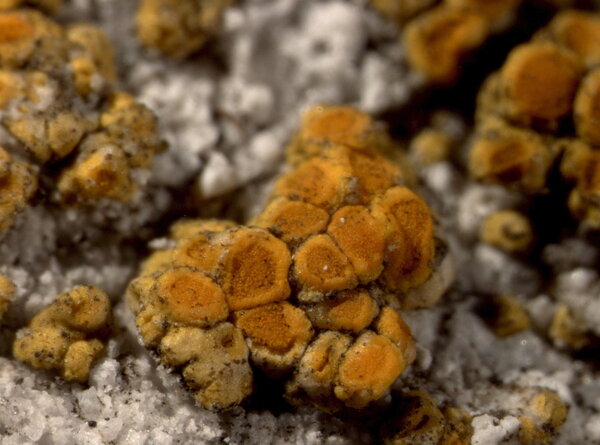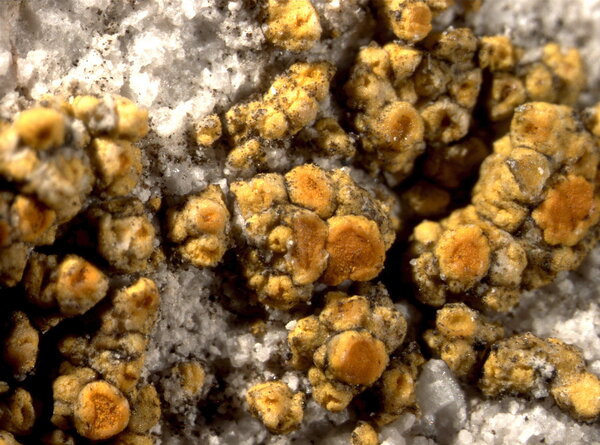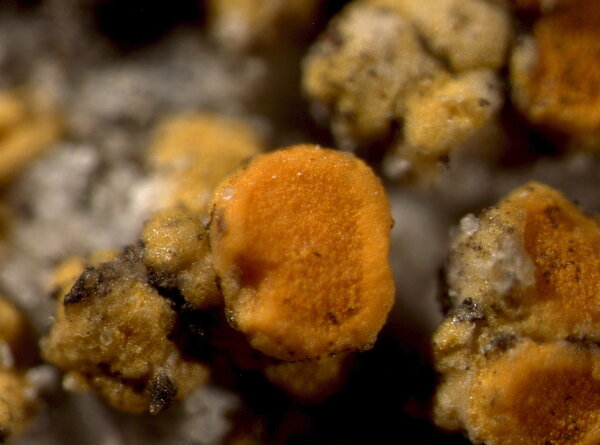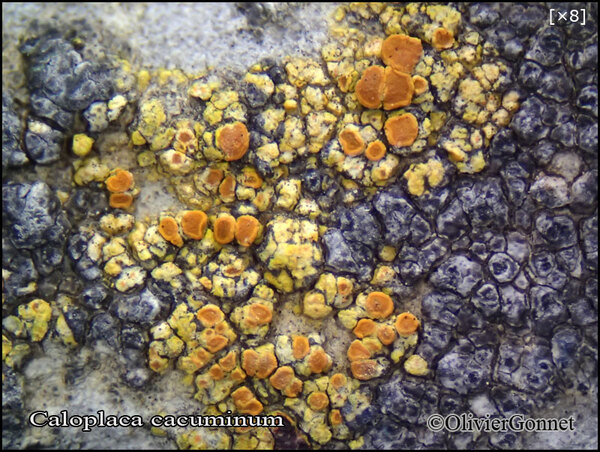Caloplaca cacuminum Poelt
Mitt. bot. Staatss. München, 1: 235, 1953.
Synonyms: Callopisma aurantiacum var. microsporum Arnold; Caloplaca aurantiaca var. microspora (Arnold) Dalla Torre & Sarnth.
Distribution: N - Frl, TAA, Piem (Matteucci & al. 2013, Favero-Longo & al. 2015), VA (Favero-Longo & al. 2006, Isocrono & al. 2008, Favero-Longo & Piervittori 2009). C - Abr (Nimis & Tretiach 1999, Gheza & al. 2021).
Description: Thallus crustose, at first perhaps facultatively parasitic, but soon becoming autotrophic, ochraceous yellow to yellow-orange, finely areolate or consisting of a few dispersed granules, when well-developed forming small, up to 2 cm wide patches. Areoles indistinct or rounded-angular, separated by deep cracks, flat to slightly convex, 0.2-0.5 mm wide, subparaplectenchymatous throughout, filled by algae which almost reach the upper surface. Apothecia zeorine, usually 1 per areole, broadly adnate to slightly constricted at base, 0.2-0.8 mm across, with a flat to slightly convex, orange disc, and a paler, yellow-orange, persistent margin. Exciple of slightly radiating hyphae; epithecium orange-brown, granular, K+ red; hymenium colourless, 60-80 µm high; paraphyses capitate, the apical cells up to 6.5 µm wide, covered by a granulose epipsamma. Asci 8-spored, clavate, functionally unitunicate, apically thickened with a broad internal beak, the inner part of apex and external cap I+ blue, Teloschistes-type. Ascospores 2-celled, polarilocular, hyaline, narrowly ellipsoid to spindle-shaped, 7-11(-13) x 3-4.5 µm, the equatorial thickening (“septum”) often poorly developed, 1(-2) µm. Photobiont chlorococcoid. Spot tests: thallus and apothecia K+ red, C-, KC-, P-. Chemistry: thallus and apothecia with unidentified anthraquinones. Note: a probably arctic-alpine species typical of Alpine peaks, found on limestone and dolomite in exposed habitats, often starting the life-cycle on other lichens; probably widespread throughout the Alps. According to Vondrák (in litt.) the few available sequences suggest that it could be a limestone variant of the silicicolous, arctic-alpine Amundsenia approximata (Lynge) Søchting, Arup & Frödén.
Growth form: Crustose
Substrata: rocks
Photobiont: green algae other than Trentepohlia
Reproductive strategy: mainly sexual
paras (often) of crustose lichens
Commonnes-rarity: (info)
Alpine belt: very rare
Subalpine belt: extremely rare
Oromediterranean belt: absent
Montane belt: absent
Submediterranean belt: absent
Padanian area: absent
Humid submediterranean belt: absent
Humid mediterranean belt: absent
Dry mediterranean belt: absent

Predictive model
Herbarium samples
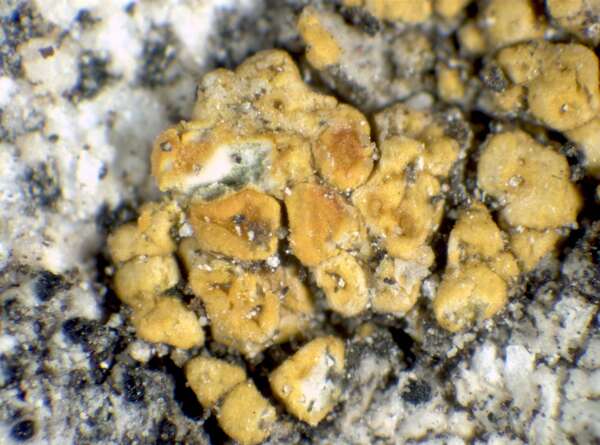

P.L. Nimis; Owner: Department of Life Sciences, University of Trieste
Herbarium: TSB (25190)
2001/12/18
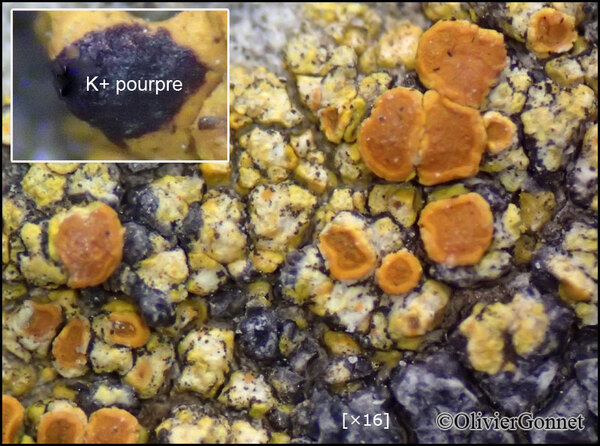
Courtesy: Olivier et Danièle Gonnet - Source: https://www.afl-lichenologie.fr/Photos_AFL/Photos_AFL_C/Textes_C6/Caloplaca_cacuminum.htm
France, Uvernet-Fours - Alpes-de-Haute-Provence - (04) - Pré des Fabres, alt. 2022 m, facultativement lichénicole, ici sur Staurothele areolata
23/7/2014
Growth form: Crustose
Substrata: rocks
Photobiont: green algae other than Trentepohlia
Reproductive strategy: mainly sexual
paras (often) of crustose lichens
Commonnes-rarity: (info)
Alpine belt: very rare
Subalpine belt: extremely rare
Oromediterranean belt: absent
Montane belt: absent
Submediterranean belt: absent
Padanian area: absent
Humid submediterranean belt: absent
Humid mediterranean belt: absent
Dry mediterranean belt: absent

Predictive model
| Herbarium samples |


P.L. Nimis; Owner: Department of Life Sciences, University of Trieste
Herbarium: TSB (25190)
2001/12/18

 Index Fungorum
Index Fungorum
 GBIF
GBIF
